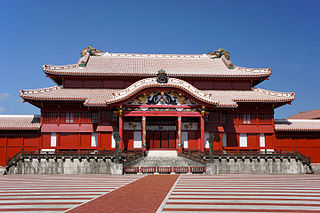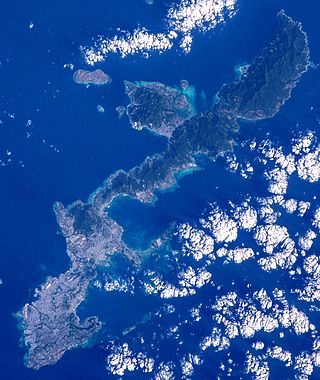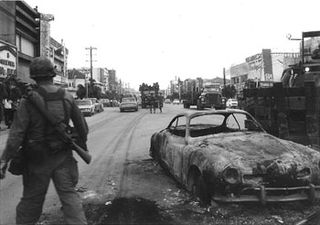
The Battle of Okinawa, codenamed Operation Iceberg, was a battle of the Pacific War fought on the island of Okinawa by United States Army and United States Marine Corps forces against the Imperial Japanese Army. The initial invasion of Okinawa on 1 April 1945 was the largest amphibious assault in the Pacific Theater of World War II. The Kerama Islands surrounding Okinawa were preemptively captured on 26 March by the 77th Infantry Division. The 82-day battle lasted from 1 April until 22 June 1945. After a long campaign of island hopping, the Allies were planning to use Kadena Air Base on the large island of Okinawa as a base for Operation Downfall, the planned invasion of the Japanese home islands, 340 mi (550 km) away.

Okinawa Prefecture is a prefecture of Japan. Okinawa Prefecture is the southernmost and westernmost prefecture of Japan and has a population of 1,457,162 and a geographic area of 2,281 km2.

United States Forces Japan (USFJ) is a subordinate unified command of the United States Indo-Pacific Command (USINDOPACOM). It was activated at Fuchū Air Station in Tokyo, Japan, on 1 July 1957 to replace the Far East Command. USFJ is commanded by the Commander, US Forces Japan (COMUSJAPAN) who is dual-hatted as commander of the Fifth Air Force. U.S. Forces Japan is currently headquartered at Yokota Air Base in Tokyo.

This article is about the history of the Ryukyu Islands southwest of the main islands of Japan.

Masahide Ōta was a Japanese academic and politician who served as the governor of Okinawa Prefecture from 1990 until 1998. After starting his career as a professor at the University of the Ryūkyūs, he wrote books in English and Japanese, mostly about the Battle of Okinawa and Japan–United States bilateral relations following World War II. After his retirement as professor he was elected as governor and was best known for his strong stand against occupation of prefectural lands by military bases of United States, going against the Japanese central government at the time.

Okinawa Island, officially Okinawa Main Island is the largest of the Okinawa Islands and the Ryukyu (Nansei) Islands of Japan in the Kyushu region. It is the smallest and least populated of the five main islands of Japan. The island is approximately 106 kilometres (66 mi) long, an average 11 kilometres (7 mi) wide, and has an area of 1,206.98 square kilometers (466.02 sq mi). It is roughly 640 kilometres south of the main island of Kyushu and the rest of Japan. It is 500 km north of Taiwan. The total population of Okinawa Island is 1,384,762. The Greater Naha area has roughly 800,000 residents, while the city itself has about 320,000 people. Naha is the seat of Okinawa Prefecture on the southwestern part of Okinawa Island. Okinawa has a humid subtropical climate.

Marine Corps Air Station Futenma or MCAS Futenma is a United States Marine Corps base located in Ginowan, Okinawa, Japan, 5 NM northeast of Naha, on the island of Okinawa. It is home to approximately 3,000 Marines of the 1st Marine Aircraft Wing and other units, and has been a U.S. military airbase since the defeat of the Japanese Imperial Army in the Battle of Okinawa in 1945. Marine Corps pilots and aircrew are assigned to the base for training and providing air support to other land and sea-based Marines in Okinawa and throughout the Asia-Pacific region. MCAS Futenma is part of the Marine Corps Installations Pacific command.

Camp Schwab is a United States Marine Corps camp located in northeastern Okinawa Prefecture, Japan, that is currently home to the 4th Marine Regiment and other elements of the 28,000 American servicemen based on the island. The Camp was dedicated in 1959 in honor of Medal of Honor recipient Albert E. Schwab who was killed in action during the Battle of Okinawa.

Camp Foster, formerly known as Camp Zukeran, is a United States Marine Corps camp located in Ginowan City with portions overlapping into Okinawa City, Chatan town and Kitanakagusuku village in the Japanese prefecture of Okinawa Island. It is part of the Marine Corps Base Camp Smedley D. Butler complex.

The Treaty of Mutual Cooperation and Security between the United States and Japan, more commonly known as the U.S.-Japan Security Treaty in English and as the Anpo jōyaku (安保条約) or just Anpo (安保) in Japanese, is a treaty that permits the presence of U.S. military bases on Japanese soil, and commits the two nations to defend each other if one or the other is attacked "in the territories under the administration of Japan". Over time, it has had the effect of establishing a military alliance between the United States and Japan.

The Ryukyu independence movement or the Republic of the Ryukyus is a political movement advocating for the independence of the Ryukyu Islands from Japan.

The 1995 Okinawa rape incident occurred on September 4, 1995, when three U.S. servicemen, U.S. Navy Seaman Marcus Gill and U.S. Marines Rodrico Harp and Kendrick Ledet, all serving at Camp Hansen on Okinawa, rented a van and kidnapped a 12-year-old Okinawan girl. They beat her, duct-taped her eyes and mouth shut, and bound her hands. Gill and Harp then raped her, while Ledet claimed he only pretended to do so due to fear of Gill. The offenders were tried and convicted in Japanese court by Japanese law, in accordance with the U.S.–Japan Status of Forces Agreement. The families of the defendants initially claimed that Japanese officials had racially discriminated against the men because they were all African American and coerced confessions from them, but later retracted the claims. The incident led to further debate over the continued presence of U.S. forces in Japan among Okinawans.

The Koza riot was a violent and spontaneous protest against the US military presence in Okinawa, which occurred on the night of December 20, 1970, into the morning of the following day. Roughly 5,000 Okinawans clashed with roughly 700 American MPs in an event which has been regarded as symbolic of Okinawan anger against 25 years of US military occupation. In the riot, approximately 60 Americans and 27 Okinawans were injured, 80 cars were burned, and several buildings on Kadena Air Base were destroyed or heavily damaged.

The 11th Okinawa gubernatorial election was held on November 28, 2010. The official campaign start began November 11. The 2010 election garnered national attention mostly for the dispute between the central government and local communities in Okinawa over the planned relocation of Marine Corps Air Station Futenma from Ginowan to Henoko in Nago that had also contributed to the resignation of prime minister Yukio Hatoyama in June 2010.

The Yumiko-chan incident was the rape and murder of five-year-old Japanese girl Yumiko Nagayama by American soldier Sergeant Isaac J. Hurt in Kadena, Okinawa on September 4, 1955. Nagayama's body was found near Kadena Air Base during the U.S. occupation of Okinawa, and an investigation led to the conviction of 31-year-old Sergeant Hurt on charges of murder, rape, and kidnapping. The Yumiko-chan Incident caused anti-American outrage in Okinawa and contributed to the first major Okinawan protests against the U.S. occupation and military presence.

Over the last five decades there have been various plans for the relocation of Marine Corps Air Station Futenma, a United States Marine Corps base located within the urban area of Ginowan City in Okinawa, Japan.
The 2016 Okinawa Prefectural Assembly election, or more formally the 12th general election of members of the Okinawa prefectural assembly, was held on 5 June 2016.
A referendum was held in Okinawa Prefecture on 24 February 2019. The referendum asked whether voters approved or opposed the landfill work at Henoko Bay for the construction of a new United States Marine Corps base. This is the second prefecture-wide referendum in Okinawa, the first being the 1996 referendum on the reduction of US military presence. Governor Denny Tamaki announced the referendum in November 2018, fulfilling his manifesto promise from his successful campaign for governor.

Naval Base Okinawa, now Naval Facility Okinawa, is a number of bases built after the Battle of Okinawa by United States Navy on the Okinawa Island of Japan. The naval bases were built to support the landings on Okinawa on April 1, 1945, and the troops fighting on Okinawa. The Navy repaired and did expansion of the airfields on Okinawa. United States Navy Seabees built or repaired the facilities on the island. The bases on Okinawa put the United States Armed Forces only 350 miles from Japan's home islands. Most facilities closed after the war, but some are still in use today in all branches of the United States Armed Forces.















